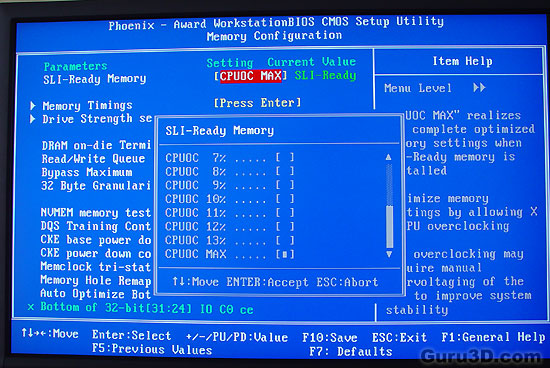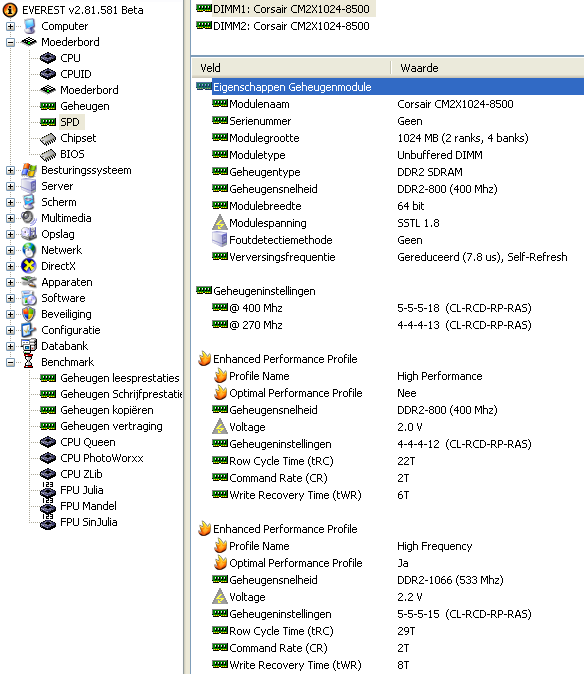Page 3
EPP aka SLI Memory - Get down with EPP (yeah you know me) ...
This is going to take some explaining as it's hard stuff to understand for the average PC user. You already have been able to learn about DDR2 EPP (SLI memory) recently as it was announced one week earlier next to the nForce 500 launch. It's very clever technology for the overclocker who does not dare or know how to configure memory at it's best in an overclocked environment.
DDR2 memory (actually pretty much any memory) uses an SPD (Serial Presence Detect) chip to store it's JEDEC certified timings and setup specifications on. Now .. a massive chunk of that SPD chip is being written as ZERO; meaning it's largely unused space. A couple of brainy guys at NVIDIA figured ... hmm, let's talk to some memory allies and see if we can do something with that extra space and utilize it for our new products to offer our buyers more options.
Since most memory is configured at JEDEC specifications the standard timings are not exactly enthusiast presets, most of us know, we can do a heck lot more with memory timings and frequency wise then the rather safe JEDEC SPD settings tell the BIOS to fire off on your memory.
Once you overclock the system bus, your memory clock will run faster in MHz also. A higher FSB usually means that will need slower timings and/or different voltages, that kind of information could be stored into the SPD in several profiles.
So basically additional non-JEDEC specified timings related towards a certain clock frequency or related to muipliers/deviders/voltages/drive strengths will be stored on that unused SPD space. This way that memory can be setup in a different way with the click of a button, or even better detected by your nForce 590 mainboard and set automatically.
So NVIDIA & Corsair (and soon others like OCZ & Kingston ) put 1+1 together and they created something called EPP. Enhanced Performance Profiles. The new and only NFORCE 590 for example will look at what your system configuration is tweaked at and see what the maximum stable tweak to seek the best (fastest yet stable) profile for the memory is. If it matches .. you'll run the best and fastest possible configuration setup on your memory based on a maximum of two full or four partly additional profiles stored on that SPD by the memory manufacturer (frequency versus timings and the entire shebang as mentioned previously).
The SPD can be programmed with two full profile types per SPD or four abbreviated profiles that will hold memory voltage, Command rate, Cycle time, CAS LAtency, tRCD, tRP and tRAS -> example 4-4-4-12-2T at 2.1 volts.
 The SLI-Ready menu in the BIOS
The SLI-Ready menu in the BIOS
I'll wrap it up now as the more we talk about it the more difficult it'll be to understand.
 So in short: you can tweak memory really easy yet this is intended for the folks that have a hard time overclocking themselves. It's a reasonably fool proof method of getting the best out of your DDR2 memory with an NFORCE 590 mainboard. Obviously you can manage memory timings and everything related to it manually also. This is just an extra feature. Look out in the stores for memory with a "SLI Ready" logo.
So in short: you can tweak memory really easy yet this is intended for the folks that have a hard time overclocking themselves. It's a reasonably fool proof method of getting the best out of your DDR2 memory with an NFORCE 590 mainboard. Obviously you can manage memory timings and everything related to it manually also. This is just an extra feature. Look out in the stores for memory with a "SLI Ready" logo.
And yeah .. the naming is a little tacky as it absolutely does not have a relation to SLI at all, but this is what to look for in the stores if you are opting EPP enhanced memory. EPP is an open standard, more memory manufacturers therefore can and will follow. Corsair, Kinston and OCZ Technology will be among the first to include EPP onto the memory SPD. For this review we'll be working with some really cool Corsair memory and all Corsair DDR2 memory effective as we speak, will have EPP SPDs.
For those that are wondering, the primary used memory in this review will be a matched pair of 1 GByte modules that can take a 1066 MHz clock at 5-5-5-15-2T timing at 2.2 volts which is based in screened Micron 64Mx8 RAMs.

Tadaa .. with the new Everest beta we can already check out the EPP profiles stored in the SPD. And yes .. that's Dutch ;)
